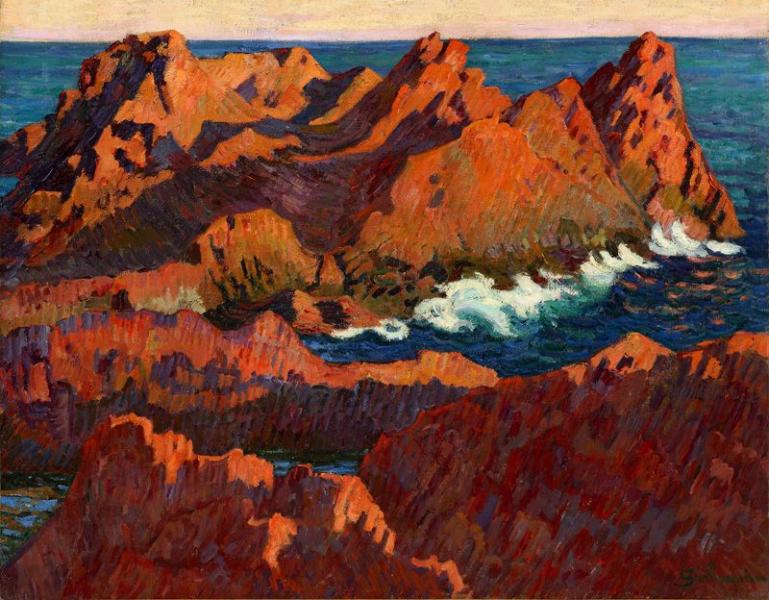L'île de Besse à Agay, 1895
Oil on canvas, signed Guillaumin lower right, dated and located " Agay Mai-Juin 95, 7H le soir " on the frame.
73 x 91.80 cm
Provenance :
Former Eugène Blot collection
France Private collection, South of France
Bibliography:
Tristan Klingsor, “Armand Guillaumin” in Art and Decoration, T.50, July 1926, painting reproduced on p.190.
Certificate of inclusion in the artist's catalog raisonné in preparation established by the Guillaumin Committee.
THE MOST FAUVE OF THE IMPRESSIONISTS
“It is still debated whether Armand Guillaumin should be classed Guillaumin among the masters of Impressionism.”
In July 1926, this point of discussion opened Tristan Klingsor's article on the artist in the magazine Art et décoration, which was illustrated by a reproduction of our painting (it was here that we learned that this work then belonged to the painter Eugène Blot).
As far as Impressionism is concerned, Guillaumin belongs to the generation of masters who gave their name to the movement. Born just one year from Monet and two from Sisley, he shares the same year of birth as Renoir's year of birth. At the Swiss Academy, where he attended evening classes, he met Renoir and Pissarro, a little older than them.
He is more likely to be associated with Pissarro, as their vision of landscape their vision of the landscape.
At first, Guillaumin looked for his motifs in the Paris suburbs. It has to be said that he had little leisure time at the time, as he worked as a sales clerk, assisting his uncle in his store selling women's lingerie until the early 1860s.
He was then employed at the Orleans railway office until 1867, before joining the Ponts et Chaussées department to paint more often on the banks of the Seine.
Between 1884 and 1886, he also painted in Essonne, at Damiette near Orsay, and sought out the effects of the ocean at Saint-Palais-sur-mer, not far from Royan.
In 1887, on the occasion of his wedding, Degas and his very close friend Paul Gauguin were his witnesses. He also knew Cézanne and the Van Gogh brothers. In 1892, he finally gave up all menial jobs to paint more freely. A substantial sum of money he had won the previous year in a lottery enabled him to devote himself to painting, or so we sometimes read. By 1906, he was exhibiting at Bernheim and in 1908 at the Rosenberg gallery. He discovered Agay in 1895, before moving on to Brittany, Auvergne, Forez and then, on the advice of one of his painter friends, Crozant in Creuse, where he settled for a long time, finding there a soothing counterpoint to the Mediterranean. In Agay, where he painted regularly, it was the violence of the contrasts that caught his eye. This ancient Estérel massif, a volcanic mass dating from the primary era, owes its unusual color to the amaranth rhyolite, the rock of which it is composed, which is very rich in phenocrysts.
The perception of the rocks, plunging into the sea, is thus very different according to atmospheric conditions and the time of day. The pink-orange hue varies in intensity from dawn to dusk.
It's obviously a favorite moment for painters and photographers, capturing the intensity of the unreal contrast between the bright orange emerging and the ultramarine blue of the Mediterranean waters. Paintings in tones as violent and saturated as the one presented here may have made Guillaumin a familiar face to the Fauves. In fact, Othon Friesz came to work alongside him in Creuse in 1901, inspired by his boldness.
However, in Agay, artists only paint what they see. The rocks truly blazed against the sea, and like Valtat's, around the same time, Guillaumin's palette was a faithful reflection of this, without extrapolation.
In fact, his approach is always entirely Impressionist. On the back of the stretcher, the inscription Agay, mai-juin 95, 7h le soir, proof if any were needed, of the authenticity of his approach.
Although he has sometimes been seen as a precursor of Fauvism, Guillaumin is probably
at least the most colorist of the Impressionists, preferring in this Cézanne to Degas.
He was also undoubtedly the most modern of them all, daring not only color but also subversive framing. Here, the framing is so tight that the sky is relegated to a horizontal band only a few centimetres high, while the foreground crashes into the viewer's face, adding to the force of the elements, to the sense of the viewer's presence. to the strength of the elements and the colorful power of the whole.
Guillaumin was not the best-known of the Impressionists. Even today, recognition of his work is tentative. Critics of the time attributed to the painter's character.
Described as a gentle, discreet man, who liked to keep his distance from coteries and conflicts, dedicating and offering most of his paintings to his friends, since he apparently had no need of money, he also kept a good distance from the art market, although he regularly exhibited in the most prestigious galleries, and most of the time alongside the Impressionists. Impressionists. His acquaintances placed him at the heart of his time, and even at the forefront of painting, since he didn't hesitate to give advice to young artists who seemed to him to have talent, influencing many of his younger contemporaries. many of his younger contemporaries.
Since his death, however, little justice has been done to him. Museum have not been particularly concerned with the artist, who is only mentioned in group exhibitions, and the exhibitions that have been devoted to him are private initiatives, such as the one held at the Galerie Gérard in 1941, or the more recent one at the Galerie Lévy in the early 2000s.
Armand Guillaumin is undoubtedly a painter to be rediscovered, and deserves to be rescued from the dungeons of Impressionism in which he has long been unjustly immersed. in which he has long been unjustly immersed.

